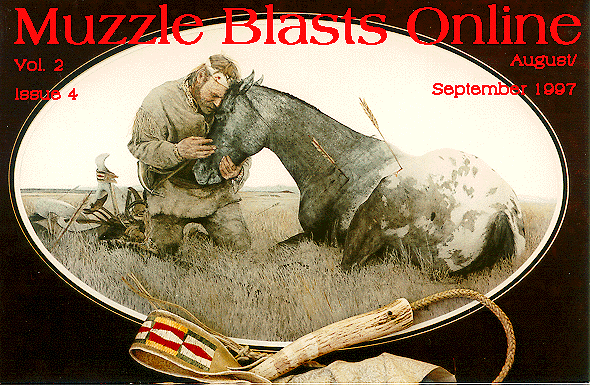Pathfinder: Lee Teter and Eastern Frontier Art
by David Arnold, Maryland
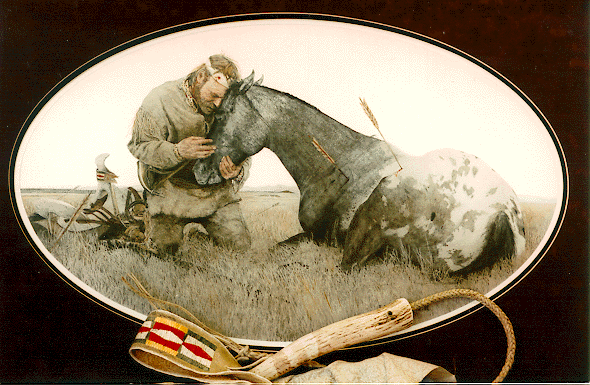
|
|
Friends and Heroes
by Lee Teter
|
James Fenimore Cooper created novels about the frontier that
became popular in the 1830's. His books, such as The Last of the
Mohicans and The Pathfinder, stereotyped inaccuracies. Cooper's
books were reinforced by the similarly emotionalize illustrations
that went with and were inspired by the books. The stereotypes
never died.
The twentieth century saw a resurgence of interest in Daniel
Boone, Davy Crocket, and their world. Artists and writers of
fiction capitalized on the interest and continued stereotypes
that blossomed with the help of Hollywood and the film industry.
Frontier art became popularized by men who were often artists
first and historians last. Then, years ago in the Appalachian
Mountains, a shy, reclusive devotee began to study, then paint
and draw the results of his research. Lee Teter had started to
paint the Eastern frontier accurately.
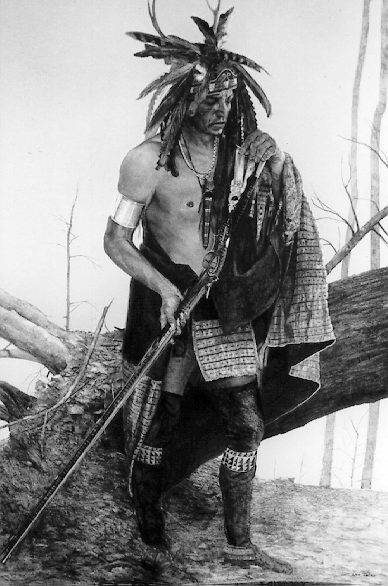
|
|
The Gift
by Lee Teter
|
Lee Teter and his pretty wife, Barbi, lived in a one-room
cabin in the Appalachian Mountains. A newborn daughter, Shawnee,
and a quest for the truth and reality of America's Eastern
frontier became the focus of their lives. They traveled as far
and as often as their few dollars would take them; to museums and
friends who had information to share. They borrowed books and
hunted down remnants of the frontier in order to know the
difference between fact and fiction. Lee Teter lived with the
derision many artists knew in an earlier century. Mountain
attitudes and comments like lazy, good-for-nothing artist made
Lee more reclusive than ever, but he continued his search for the
reality of the past. Lee believed that people craved the truth
about their past, and slowly but surely Lee's work was collected
by a few people. His first drawings sold for $50.00. That was a
lot of money to the former farm boy. The work was slow, and sign
painting contributed to the family income. Research was
difficult. There was no repository of sifted information arranged
in proper context, and no other artist was focused on accurately
portraying the Eastern frontier. Lee was not alone, however. He
had friends who were willing to join him on freezing nights with
wool blankets and frozen moccasins in order to separate fact from
fiction. Together Lee and friends built a 26-foot dugout canoe,
tanned hides and wore out moccasins with mountain miles. All
contributed in their own way to the art that slowly emerged from
the pencil of the shy artist. The gun collectors and flintlock
builders shared knowledge dear to their hearts. People with very
focused interests such as powder horns or 18th-century eyeglasses
filled Lee's hours and notebooks with tiny details only people
with their passion would notice. Lee tried to repay them by
making such wealth of detail a part of his art.
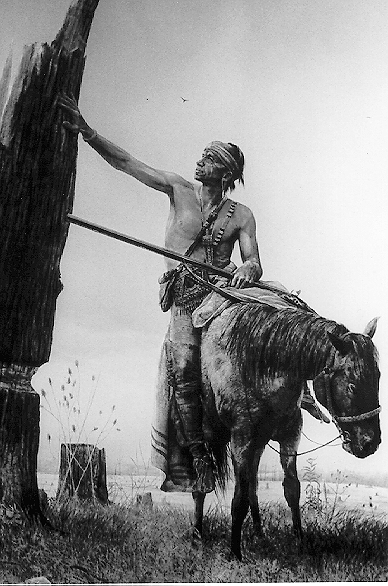
|
|
Touching Memories
by Lee Teter
|
Lee's dedication to Eastern frontier art was interrupted
only by a painting he created and promoted for Vietnam Veterans
in 1987 called Reflections. The now world-famous painting
received the same heart and soul as he continues to put into his
frontier art. The painting was first unveiled at a black powder
shoot in Virginia and support found there helped finance the
first printing. The prints were, with the assistance of dedicated
veterans, promoted and marketed successfully. The veterans went
on to reap several million dollars from the sale of prints from
Lee's painting. Nearly ten years later their print continues to
sell by the hundreds.
When the veterans were on their feet, Lee continued to study
the frontier and travel and study and draw...and study.
Lee traveled to shows related to flintlocks and frontier. He
took his art from door to door at many galleries and frame shops
and was turned away. No one seemed to understand that the strange
figures in Lee's art were the real figures once common on the
early American frontier. Magazines refused to print pictures with
detailed accuracy that might upset some of their clientele, or
that portrayed people they thought their readers would not
recognize. Lee found a small West Virginia gallery and another in
Western Maryland that sold enough of his work to allow him to
continue his drawings and his studies. He never gave up.
Full-color prints were costly, and no investors were willing to
risk their money on such an alien theme as historical truth. The
galleries complained that they needed color in order to sell art.
Lee responded by hand painting the black and white prints he
could afford to produce. The color, along with the extremely
detailed educational dissertations delivered by a shy but excited
Lee at gun shows and a few small galleries, began to create a
following.

|
|
Daddy's Girl
by Lee Teter
|
As time passed, people gradually became familiar with Lee's
art. Lee was establishing a reputation for cultural accuracy in
this new field of art. Interest grew one person at a time, one
gun show at a time, one collector at a time. During the ground
swell of interest, respected artist Robert Griffing called Lee to
inquire about the market for Eastern frontier art. Re-enactors
who were curious about depictions of artifacts in Griffing's
paintings were referred by that artist to Lee Teter for
information on details. Apparently Robert Griffing recognized the
excellence of Lee Teter's research and sensed the interest and
respect for Lee Teter's art and knowledge.
Study was paramount to Lee, and an opportunity to study was
provided by film director Michael Mann of Twentieth Century Fox.
The film The Last of the Mohicans was being produced for a 1991
release and Michael appreciated Lee's knowledge and willingness
to share it. The grilling questions by various technicians whose
job it was to recreate the world Lee held in his mind were
answered, but Lee would give only answers that could be
documented. He flew to New York and traveled to Canada where he
had been studying with Dr. Ted Brasser in order to find answers
for difficult questions. The reclusive artist lived with jet
planes, bell hops, and limousines for the first time in his life.
Lee's focus remained cultural and historical authenticity, and
when he found that several prominent inaccuracies of the film
were not to be corrected, Lee returned to his home in the
mountains so he would not be part of perpetuating stereotypes he
was fighting with his art.
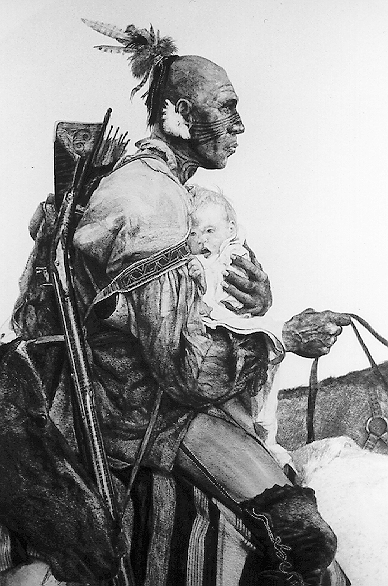
|
|
Captive Hearts portrays one of the aspects of American Indian warfare that has received little attention from the art world due to the harshness and unpopularity of the subject. Lee paints this event without pulling any punches and yet with such tenderness that we can't help but feel reassured as we witness the beginning of a new family relationship.
|
He realizes that popularity of the
film increased interest in the subjects he admires so much and
feels that the film served a good purpose in spite of its
imperfections. He continues to ridicule the mistakes in the film
but admits that there are many things that turned out right for
the first time in film history. Michael Mann feels that the
influence was important to actors Daniel Day Lewis, Eric Schweig,
Russell Means, and Wes Studi, along with costume designers and
others. Lee enjoyed the company of the actors he influenced and
laughed when he remembered Daniel Day Lewis' grinding the gears
in his antique pickup or Wes Studi's (who played Magua), cutting
his thumb on the rear sight of Lee's smoothbore as he practiced
bringing it up to fire. Lee enjoyed going back home to his art
where everything could be represented properly. He left the
futile film job to others. Mann's respect for Lee's art is
evident and he states that It is Lee's unique power to transcend
the present and drop one into another's life in a frozen moment
of another time that makes his work such fine art. Mann continued
to verify information he was receiving by calling Lee at home.
Director Michael Mann and Lee Teter remain friends and mutual
admirers.
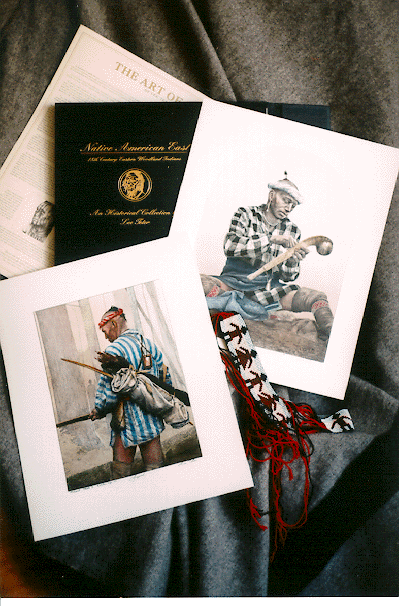
|
|
At the beginning of his career, Lee took his art from door to door at many galleries and frame shops and was turned away. He responded by hand painting the black and white prints. The color, along with the extremely detailed educational dissertations delivered by Lee at gun shows and a few small galleries, began to create a following.
|
As time passed the reclusive artist began to find ever
growing interest in his work, and his success and popularity
reflected that interest. Major art publishers expressed interest
in his art, but Lee was hesitant to put artistic control in their
hands, and he rejected their offers. He still hand paints each
print instead of marketing reproductions, and in each edition
commonly only 95 prints will be published. His work is in great
demand by galleries across the country, and prints that sold for
$200.00 a year ago are bringing up to $3,000.00 at the present.
He doesn't consider his art to be historical as much as
historical surrealism which was defined by writer Bill Gilbert as
being a creation compounded of fragments of fact rearranged in
surrealistic patterns. Lee paints the people who never made it
into the history books or records, people of his imagination or
unnamed people in journals and diaries, and yet who are founded
in fact. Fact so well researched that Lee can give you a thread
count of the fabric or tell you how thick a silver ornament might
be. He feels that the only things that haven't changed with time
are the human spirit and human attitudes. Lee puts himself in as
nearly the same physical and mental conditions as possible, and
then creates a picture that is rooted in the present and the past
of those experiences. He dresses those experiences in the
accurately detailed material culture that Lee and so many others
find fascinating.
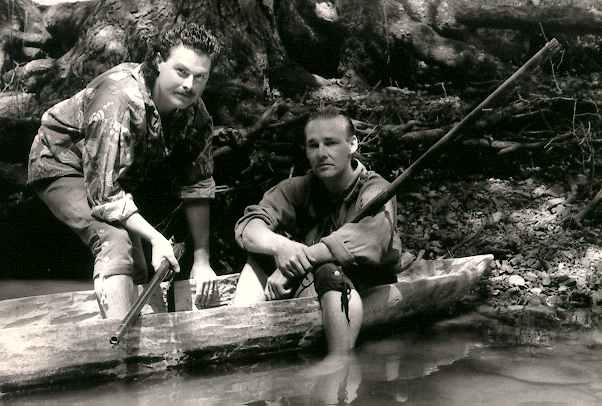
|
Lee loves making new discoveries about an old frontier. He
loves sharing those discoveries just as Simon Kenton and Daniel
Boone loved showing the frontier to newcomers; and like the
Americans before him Lee Teter needs the frontier. He recently
moved to Wyoming in order to experience the solitude and vast
emptiness and make them part of his soul. That is where his art
resides until it makes its way onto paper and canvas. His 37
years in the Appalachian Mountains have given him a love of
Eastern history just as his reclusive spirit has given him a need
for quiet. I can ride my horse for a week in one direction and
not pass a house or electric pole. I need to know how that feels
so I can put it in my pictures. This same unrestricted feeling
once existed in the East says Lee.
Lee Teter has broken and will continue to break the paths
other artists will surely follow. Watch carefully as a quiet
artist sees the future in our past and pursues it. He will be
hard to keep up with as always, because he will always be beyond
the edge of what is known and comfortable. In this artist is a
heart that refuses to give in, that travels the trails that
others only wonder about. Lee Teter is a pioneer; he is a
pathfinder.
